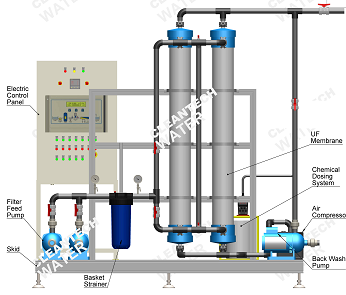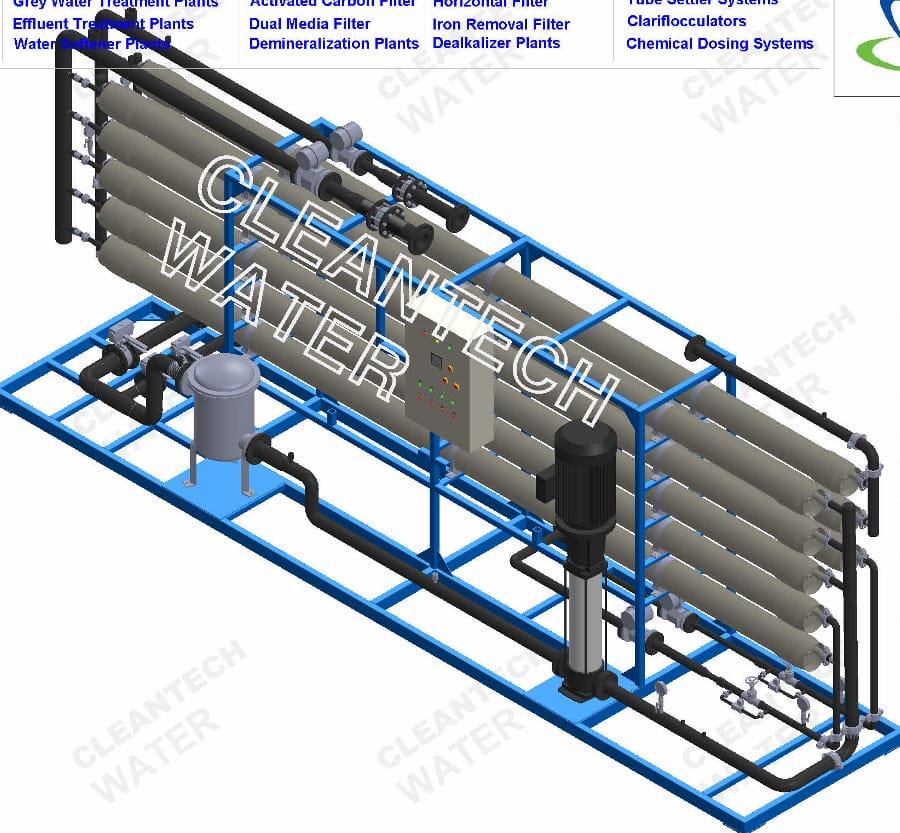In wastewater treatment, the selection of appropriate filtration systems is paramount for maintaining water quality and ensuring environmental sustainability. Among the array of mechanical filtration options, four prominent methods stand out: Microfiltration (MF) water system, Ultrafiltration (UF) water system, Nanofiltration (NF) water system, and Reverse Osmosis (RO) water system. Each technique offers distinct advantages and applications tailored to specific water treatment needs.
In this comprehensive guide, we will delve into the characteristics, applications, and benefits of each filtration method, aiding property owners and businesses operating water and wastewater treatment plants in making informed decisions for their facilities.
4 Types of Mechanical Filtration Systems
Mechanical filtration systems play a vital role in separating impurities from water based on size, molecular weight, and other physical properties. While these 4 methods share the common goal of purifying water, each one operates on different principles, offering unique benefits and applications. Let us understand them one by one in detail:
1. What is a Microfiltration (MF) Water System?
Microfiltration (MF) is a mechanical filtration process that employs membranes with pore sizes ranging from 0.1 to 10 micrometres, effectively removing suspended solids, bacteria, and some viruses from water. This method relies on size exclusion, allowing water molecules to pass through while blocking larger contaminants.
Applications of Microfiltration Include:
- Drinking Water Treatment: MF is commonly used in municipal water treatment facilities to remove turbidity, suspended solids, and pathogens, ensuring safe and potable drinking water.
- Wastewater Treatment: In industrial and municipal wastewater treatment plants, MF serves as an essential step in removing particulate matter and microorganisms before further processing.
- Food and Beverage Industry: It is utilised for clarifying juices, wines, and dairy products, enhancing product quality and extending shelf life.
- Pharmaceuticals: In pharmaceutical manufacturing, MF ensures the purity of process water, preventing microbial contamination and meeting stringent quality standards.
By efficiently removing contaminants while maintaining high water flux rates, microfiltration systems offer a cost-effective solution for various water treatment challenges.
2. What is an Ultrafiltration (UF) Water System?
 Ultrafiltration (UF) water system is a membrane filtration process that operates on a smaller scale than microfiltration, with pore sizes typically ranging from 0.001 to 0.1 micrometres. UF membranes effectively remove colloidal particles, bacteria, viruses, and high molecular weight substances from water, producing high-quality permeate.
Ultrafiltration (UF) water system is a membrane filtration process that operates on a smaller scale than microfiltration, with pore sizes typically ranging from 0.001 to 0.1 micrometres. UF membranes effectively remove colloidal particles, bacteria, viruses, and high molecular weight substances from water, producing high-quality permeate.
Applications Of Ultrafiltration Water Systems Include:
- Pre-treatment for Reverse Osmosis: UF is often employed as a pre-treatment step before reverse osmosis to remove suspended solids, bacteria, and other contaminants, prolonging the lifespan of RO membranes and improving overall efficiency.
- Industrial Water Recycling: it plays a crucial role in treating industrial wastewater for reuse in processes such as cooling towers, boiler feedwater, and production processes, reducing water consumption and environmental impact.
- Desalination: In seawater desalination plants, UF assists in removing suspended solids and organic matter, improving the efficiency of subsequent desalination processes.
- Biotechnology: It is utilised in biopharmaceutical manufacturing, protein purification, and enzyme concentration, facilitating precise separation and purification of biomolecules.
With its versatility and ability to produce high-quality permeate, the ultrafiltration water system is widely adopted across industries for various water treatment applications.
3. What is a Nanofiltration (NF) Water System?
Nanofiltration (NF) stands as a pivotal filtration technique, operating on a scale between ultrafiltration and reverse osmosis. The membranes used in NF have pore sizes ranging from 0.001 to 0.01 micrometres, allowing for the selective removal of divalent ions, organic matter, and certain dissolved substances while retaining monovalent ions and water molecules. This selective separation capability makes NF an ideal solution for various water treatment challenges.
Applications of Nanofiltration include:
- Water Softening: NF is commonly employed for water softening applications, removing calcium, magnesium, and other hardness ions to improve water quality for industrial processes and household use.
- Colour and Odor Removal: In municipal water treatment plants, NF is utilised to remove colour, odour, and taste-causing compounds, enhancing the aesthetic qualities of drinking water.
- Wastewater Reclamation: It is crucial in treating secondary effluent and industrial wastewater for reuse in non-potable applications such as irrigation, industrial processes, and cooling water.
- Selective Ion Removal: NF membranes can selectively remove specific ions, making them valuable in industries such as food and beverage, pharmaceuticals, and electronics for controlling water quality and process efficiency.
With its ability to selectively remove contaminants while maintaining high water permeability, nanofiltration is a versatile solution for a wide range of water treatment applications.
4. What is a Reverse Osmosis Water System?
Reverse Osmosis (RO) stands as one of the most effective water purification techniques. It employs semi-permeable membranes to remove ions, molecules, and larger particles from water. In RO, water is forced through a membrane under pressure, leaving behind contaminants and producing highly purified water known as permeate.
Applications of Reverse Osmosis Include:
- Desalination: RO is widely used in seawater and brackish water desalination plants to produce fresh water suitable for drinking, agriculture, and industrial processes.
- Drinking Water Purification: RO systems are commonly installed in households, businesses, and municipal water treatment plants to remove dissolved solids, contaminants, and microorganisms, ensuring safe and high-quality drinking water.
- Boiler Feedwater Treatment: In industrial applications, RO serves as an essential step in boiler feedwater treatment, preventing scale formation and corrosion in boilers and other equipment.
- Wastewater Reuse: RO is utilised in wastewater treatment plants to produce high-quality effluent for reuse in various industrial processes, irrigation, and environmental restoration projects.
With its exceptional purification capabilities and versatility, reverse osmosis has become a cornerstone technology in water treatment, addressing diverse water quality challenges with efficiency and reliability.
What’s the Difference Between Micro, Nano, and Ultra Filtration
The primary differences between microfiltration (MF), ultrafiltration (UF), and nanofiltration (NF) lie in the size of particles they can effectively remove and the selectivity of their membranes. MF operates on a larger scale, removing suspended solids, bacteria, and some viruses with pore sizes ranging from 0.1 to 10 micrometres.
UF, with pore sizes ranging from 0.001 to 0.1 micrometres, removes colloidal particles, bacteria, and high molecular weight substances, offering finer filtration than MF. NF, with pore sizes ranging from 0.001 to 0.01 micrometres, selectively removes divalent ions and organic matter while retaining monovalent ions and water molecules.
As for which option is best, the choice depends on specific water treatment requirements, including the type and concentration of contaminants, desired water quality, flow rates, and operational constraints. While MF is suitable for removing larger particles and microorganisms, UF and NF offer finer filtration and selective removal capabilities. RO, on the other hand, provides the highest level of purification by removing dissolved solids and molecules through a semi-permeable membrane. Ultimately, the optimal solution often involves a combination of these filtration methods tailored to meet the unique needs of each water treatment application. It is best to consult a professional water treatment company to get expert recommendations according to your needs.
Comparison Table
Below is a comparison table illustrating the effectiveness of Microfiltration (MF), Ultrafiltration (UF), Nanofiltration (NF), and Reverse Osmosis (RO) in treating various contaminants commonly found in wastewater:
|
Contaminant |
Microfiltration | Ultrafiltration | Nanofiltration |
Reverse Osmosis |
| Wastewater |
✘ |
✘ | ✘ |
✘ |
| Bacteria |
✔ |
✔ | ✔ |
✔ |
| Calcium |
✔ |
✘ | ✔ |
✔ |
| Copper |
✔ |
✔ | ✔ |
✔ |
| Cysts |
✔ |
✔ | ✔ |
✔ |
| Fluoride |
✔ |
✘ | ✘ |
✔ |
| Lead |
✔ |
✔ | ✔ |
✔ |
| Magnesium |
✔ |
✘ | ✘ |
✔ |
| Nitrates |
✔ |
✘ | ✘ |
✔ |
| Pharmaceuticals |
✔ |
✔ | ✔ |
✔ |
| Protozoa |
✔ |
✔ | ✔ |
✔ |
| Salts |
✔ |
✘ | ✘ |
✔ |
| Sulfates |
✔ |
✘ | ✘ |
✔ |
| TDS |
✔ |
✘ | ✘ |
✔ |
| Viruses |
✘ |
✔ | ✔ |
✔ |
This table highlights the unique capabilities of each filtration method in addressing specific contaminants present in wastewater.
FAQs
Q: Can I use multiple filtration methods together for enhanced water purification?
A: Yes, combining multiple filtration methods such as microfiltration, ultrafiltration, nanofiltration, and reverse osmosis can indeed enhance water purification efficiency. This approach, known as multi-stage filtration, allows for the removal of a wider range of contaminants and ensures superior water quality tailored to specific needs.
Q: How often do I need to replace the membranes in an ultrafiltration water system?
A: The frequency of membrane replacement in an ultrafiltration water system depends on various factors. Some of these include feedwater quality, operating conditions, and maintenance practices. Generally, membranes may need replacement every 1 to 5 years. However, regular monitoring and performance evaluations are essential to determine the optimal replacement schedule.
Q: Can nanofiltration systems remove all types of dissolved salts from water?
A: While nanofiltration systems are effective at removing divalent ions and certain dissolved substances, they may not eliminate all types of dissolved salts. Reverse osmosis (RO) is typically more efficient in removing a broader range of salts. It is a preferred choice for desalination and producing low TDS (Total Dissolved Solids) water.
Q: Are there any environmental benefits associated with using filtration systems in wastewater treatment?
A: Yes, filtration systems play a crucial role in wastewater treatment by reducing the discharge of pollutants into natural water bodies, thus mitigating environmental pollution. Additionally, reclaimed water from filtration processes can be reused for irrigation, industrial processes, and environmental conservation efforts. This promotes water sustainability and reduces freshwater demand.
Cleantech Water Provides Tailored Solutions for Wastewater Treatment Plants
Experience the difference with our advanced water filtration solutions tailored to meet your specific needs. At Cleantech Water, we pride ourselves on delivering cutting-edge technologies and unparalleled expertise to optimise your water treatment processes. Whether you’re a property owner seeking efficient wastewater treatment solutions or a business operating a water treatment plant, our dedicated team is here to assist you every step of the way.
From designing customised ultrafiltration water systems to providing comprehensive maintenance and support services, we are committed to ensuring the highest standards of water quality, sustainability, and compliance. Let us help you transform your water treatment operations with innovative solutions that enhance efficiency, reduce costs, and safeguard the environment. Take the first step towards cleaner, safer water today. Contact us at +91-9558996411 or email us at Info@cleantechwater.co.in to learn more about how our company can make a difference for you.


